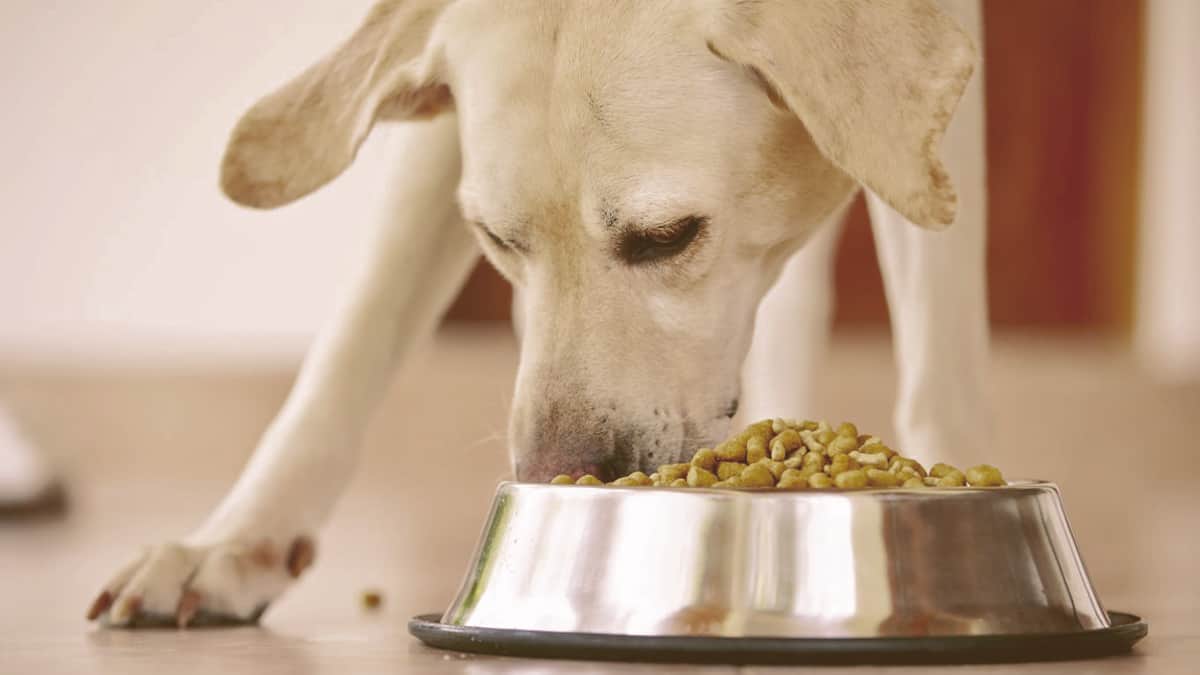5 Best High Fiber Dog Foods (2025 Edition)
Alex Vicente • Updated on August 22, 2023
- This review contains affiliate links. Read more here.
- Not a substitute for professional veterinary help.
The best high fiber dog food is the Nutro Natural Choice Dry Dog Food as the best one, in case you’re in a hurry and just want to find out what our top recommendation is.
When you think of dog food, you probably think of meat. After all, dogs are carnivores, and they need a primarily meat-based diet to survive. However, to thrive, they also need fiber.
Fiber helps dog digestive systems operate at the highest level. For dogs with specific health problems, a diet high in fiber can help keep them healthy. However, it’s not always easy to know what type of high-fiber diet will work best.
Today, let’s take a close look at the best high fiber dog food. You can check out five mini-reviews of products that can help below and then read an easy-to-understand guide on selecting the right food based on your dog’s specific needs.
Table of Contents
The Top 5 High-Fiber Dog Foods
Here are five high-fiber dog food options you’ll want to check out:
Nutro Natural Choice Dry Dog Food: Rich In Nutrients, Full Of Flavor.
Each recipe is crafted with a high-quality protein source like beef, chicken, lamb, or venison meal as the #1 ingredient your dog will love.
Nutro Natural Choice is an excellent dry food for helping your dog lose weight. Its primary ingredient is farm-raised chicken, which provides the six amino acids dogs need for proper muscle growth.
However, the weight loss properties are mainly the result of the grains. The top three are whole grain brown rice, whole grain sorghum, and rice bran. This combination of soluble and insoluble fiber helps maintain optimal digestive efficiency, while also making the dog feel full with less food.
- Pros
- Farm-raised chicken is the number one ingredient
- Includes soluble and insoluble fiber
- Effective at controlling weight
- Cons
- Recent formula change can upset stomach
- Includes soluble and insoluble fiber
- Effective at controlling weight
Specialized Nutrition for Overweight and Less Active Dogs
Purina Pro Plan Weight Management formulas have less fat than comparable Pro Plan formulas and are optimized to maintain muscle mass during weight loss.
Chicken and rice is a winning combo for dogs with digestive issues. Purina Pro Plan’s Weight Management Formula has real chicken as the number one ingredient, which helps your dog retain healthy muscle even as he loses weight.
The formula contains wheat bran, which acts as a prebiotic. By boosting your dog’s digestive system functioning, weight loss is easier and faster. Additionally, this food contains about 25% less fat than similar competing formulas.
- Pros
- The first ingredient is real chicken
- Helps boost muscle and lose fat
- Contains wheat bran, a prebiotic
- Up to 25% less fat than competitors
- Cons
- Food has a strong smell
- Can increase gas in dogs
- Contains wheat bran, a prebiotic
- Up to 25% less fat than competitors
The balanced diet that nature intended.
Every Taste of the Wild recipe is formulated with unique protein sources, real vegetables and fruits and premium ingredients that provide complete nutrition in rich flavors that will satisfy the wild taste your pet craves.
Taste of the Wild has two key features that benefit many dogs with stomach issues: It has a novel protein, and it’s packed with fiber.
Dogs can develop allergies to proteins that they’ve eaten without issue for years. The solution is to switch to a food with a protein the dog has never had before, and in most cases, bison and venison fit that requirement.
Additionally, the formula has sweet potatoes, peas, and a variety of fruits, including blueberries and raspberries. It’s highly digestible with probiotics to help boost GI tract health.
- Pros
- Helps dogs with food allergies
- Contains a variety of fruits and veggies
- Highly digestible formula
- Easy on sensitive stomachs
- Cons
- Not ideal for some diabetic dogs
- Recently switched from all-meat formula
- Highly digestible formula
- Easy on sensitive stomachs
Hill’s formulates unique foods for healthy dogs of every age, size and need.
Every bag of Science Diet uses leading-edge science for lifelong health.
Small dogs are often prone to sensitive stomachs, so if your little guy has digestive issues, Hill’s Science Diet for Small Breeds is specifically formulated to help.
The main ingredient is chicken, followed by Brewer’s rice. It’s highly digestible and nutritious but has a relatively low 392 calories per cup. Additionally, prebiotic fiber helps maintain GI health.
Plus, the kibble is only 3mm across. It’s built for small mouths, and with a rounded shape, it won’t hurt your dog’s mouth when chewed.
- Pros
- Helps calm sensitive stomach
- Includes Brewer’s rice for prebiotic fiber
- Kibble size designed for small breeds
- Cons
- Kibble size might be too large for minis
- Doesn’t always effectively treat itchy skin
- Kibble size designed for small breeds
Health Starts in the Gut.
The healthy fibers, prebiotics, probiotics and enzymes in Perfect Poop are powerful, and like with any new food or supplement may take your dog some time to adjust to.
We suppose the name says it all. Bernie’s Perfect Poop is a high-fiber formula consisting of four different supplements. It’s a blend of fiber, prebiotics, probiotics, and enzymes. Each ingredient works together to revitalize your dog’s digestive tract.
The sources of fiber include miscanthus grass, pumpkin powder, and flax seed fibers. Note that it’s considered a supplement, which means you mix it in with your dog’s existing food. It’s an excellent option if your dog needs a high-fiber diet but turns his nose up at the other options on our list.
- Pros
- High-fiber supplement
- Ideal for picky eaters
- A unique blend of fiber, pre-, and probiotics
- Includes miscanthus grass, pumpkin, and flaxseed
- Cons
- Requires a second type of food
- Requires fairly substantial serving per meal
- A unique blend of fiber, pre-, and probiotics
- Includes miscanthus grass, pumpkin, and flaxseed
Guide to High Fiber Dog Food
Dogs get most of their nutrition from animal sources, but they have a limited ability to absorb nutrients from plant-based sources, too. Fiber is a necessary part of a healthy diet for dogs. Let’s take a closer look at what fiber is, what it does, and how much your dog needs.
What is Fiber?
Fiber is an indigestible carbohydrate material. It’s found in cell walls, which aren’t a part of animal cells. Instead, fiber is only found in plant-based materials. Common fiber sources include fruits, vegetables, grains, and seeds. It has a variety of health benefits, most of which are related to digestive function.
Fiber is divided into two types:
- Soluble
- Insoluble
Each has different benefits. Here’s a closer look:
Soluble
This type of fiber dissolves in water. Some types of water-soluble fiber are also prebiotics.
A dog’s digestive system doesn’t do much with soluble fiber on its own. Instead, the fiber acts as food for bacteria that live in the large intestine. The bacteria break the fiber down into short-chain fatty acids, also known as volatile fatty acids.
These fatty acids provide valuable energy for digestive system cells. When the digestive system uses this energy, it operates more efficiently and effectively. Gut health, immune system function, and digestion all improve.
On the downside, when the bacteria consume soluble fiber, fermentation occurs. Fermentation in the gut often leads to excess gas. However, gas is often minimized if fiber is introduced slowly into your dog’s diet.
Insoluble
Dogs can’t digest insoluble fiber. Instead, it passes through the digestive system unchanged and unaltered. At first, this might not sound like much of a benefit, but it’s actually incredibly effective at stimulating the gastrointestinal tract.
Unlike soluble fiber, the insoluble type can be introduced quickly into your dog’s diet. That’s great news if your dog suffers from an occasional bout of constipation or diarrhea. Insoluble fiber doesn’t produce fermentation, so it doesn’t cause excess or other gastro issues.
ALSO READ: High-Fiber Dog Food for Anal Gland Problems
What Foods Have the Best/Most Nutritious Fiber?
You’ll find no shortage of foods that proclaim something like they’re “high in fiber” or “contain 100% of your dog’s fiber needs.” Beware of marketing hype. You want to read the ingredients carefully to see what foods the fiber is derived from.
Fiber has different properties based on its source. Many less-than-stellar manufacturers use bulky fiber that boosts the overall weight of the food bag but provides little in the way of nutrition.
Excellent sources of soluble fiber commonly found in dog food:
- Oats
- Beans (Legumes)
- Barley
- Rice
- Beets
- Apples
Excellent sources of insoluble fiber commonly found in dog food:
- Wheat bran
- Oat Bran
- Potatoes
- Cereals
- Carrots
Watch out for dog foods with an abundance of peas. While they’re a source of fiber, they typically don’t have as much fiber as many other sources. Peas are one of the most common sources of filler in dog foods.
Additionally, while fruit is often an excellent source of fiber, you want to avoid foods with a high fruit content when feeding a diabetic dog. However, other types of fibers do have benefits for a diabetic dog, and we’ll cover those in a further down.
The Benefits of High Fiber Diet
Generally, fiber benefits the entire gastrointestinal system. More specifically, a high-fiber diet is usually used to treat the following canine conditions:
Constipation
Insoluble fiber is an effective treatment for both short-term and chronic constipation. The dog’s digestive system can’t digest it, so it passes through the entire intestinal tract. As it moves through the colon, it collects moisture from outside the colon. The moisture helps stool move out of the body.
Pumpkin and oats are often good choices if you need immediate constipation relief, while any of the sources of insoluble fiber listed above work well to keep your dog regular.
Diarrhea
Although it seems counterintuitive, fiber treats both constipation and diarrhea. It’s what’s called a “stool normalizer.” Increasing fiber content is usually the first strategy when faced with any problem related to irregular bathroom habits.
When used to treat diarrhea, fiber absorbs water from inside the colon, which helps solidify the stool. As with constipation, pumpkin is also an effective treatment for diarrhea.
Anal Gland Issues
Canine anal glands secrete a strong-smelling liquid. It’s emitted whenever your dog has a bowel movement or rubs his rear against the ground. Expressing anal glands has two benefits:
- It helps a dog mark his territory
- It helps lubricate his stool
Sometimes, anal glands can become impacted or too full. If the dog has difficulty expressing his glands, he’ll become uncomfortable. You’ll want to have your dog’s anal glands checked out by your vet as part of routine health care.
An occasional blockage usually isn’t cause for concern. However, frequent blockage often indicates a gastrointestinal issue. You’ll want to increase your dog’s intake of both soluble and insoluble fiber.
Colon Cancer
A high fiber diet helps reduce the risk of colon cancer in dogs. By keeping your dog’s bowel movements regular, waste doesn’t have a chance to linger in the colon, where toxins are exposed to the intestinal walls. As exposure to toxins is reduced, so is the risk of developing colon cancer.
Pay attention to any changes in your dog’s bathroom habits. Both frequent constipation and diarrhea can be early warning signs of colon cancer in dogs.
Obesity
Insoluble fiber helps combat obesity. It works by adding volume to the food, a concept also known as diluted calorie content. As the fiber absorbs water in the intestinal lining, the dog’s digestive system sends a signal to the dog’s brain that he’s not hungry anymore.
Basically, high-fiber foods make dogs feel full faster than low-fiber foods. Additionally, they feel fuller longer, and with no loss in overall nutrition.
Diabetes
High-fiber foods can help control diabetes. Fiber slows the breakdown of food, which, in turn, helps reduce spikes in blood sugar. A steady high-fiber diet is often part of a larger plan for controlling a dog’s diabetes.
However, if your dog has diabetes, always talk to your vet before switching your dog to a high-fiber diet. Not every diabetic dog benefits from this type of diet. You and your vet will develop a diabetes treatment plan together.
Pancreatic Insufficiency
Exocrine pancreatic insufficiency (EPI) is a fairly common digestive issue in dogs. The pancreas, due to genetics or illness, becomes unable to produce specific enzymes. The body’s ability to absorb nutrients from food suffers, resulting in a variety of health problems.
Soluble fibers help make the food easier for the body to break down and absorb. However, it’s a delicate balance. Dogs with EPI can’t have a diet too high in fiber, so you’ll need to work with your vet to determine what’s right for your dog’s specific situation.
How to Switch Your Dog’s Diet
Never immediately switch out your dog’s current diet with a new one. Instead, changing diets should take about a week or more.
Mix increasing portions of the new food into the old. Note that you’re not increasing your dog’s daily food consumption. For example, if he normally gets a cup of food each day, you’ll give him a quarter-cup of old food mixed with three-quarters of a cup of the old food.
The American Kennel Club recommends the following schedule:
- Day 1: 25% new / 75% old
- Day 3: 50% of each
- Day 5: 75% new / 25% old
- Day 7: First day of 100% new
Seven days is only a guideline. If your dog has any health issues, especially related to gastrointestinal disease, you’ll want to lengthen the transition period. Doubling the time, and allowing the dog’s system to grow accustomed to each blend, helps prevent stomach upset and related issues.
What is a High Fiber Diet?
Most regular dog food has a fiber content between 2% to 5%. That’s usually fine for healthy dogs. However, if they develop any of the issues above, you’ll want to up the fiber content in their food.
Specifics vary by brand, but high-fiber dog foods typically have a fiber range from 5% to 8%. If your dog has specific, usually serious issues, your vet might prescribe high-fiber food with a fiber content as high as 12%.
Additionally, supplements are available. You can find high-fiber treats, or simply feed your dog high fiber foods such as pumpkin or apple slices.
Still Trying To Decide On The Best High Fiber Dog Food?
While your dog always needs a primarily meat-based diet, don’t forget about the importance of fiber. All of the high-fiber foods listed above have plenty of benefits. However, if we had to pick a clear winner, we choose Nutro Natural Choice Dry Dog Food.
We like how it contains both soluble and insoluble fiber, so your dog gets a wide range of benefits. Your dog will gain the benefits of improved digestion, plus it’s an effective food for weight loss. With the right high fiber food, you and your dog will enjoy many healthy years together.










